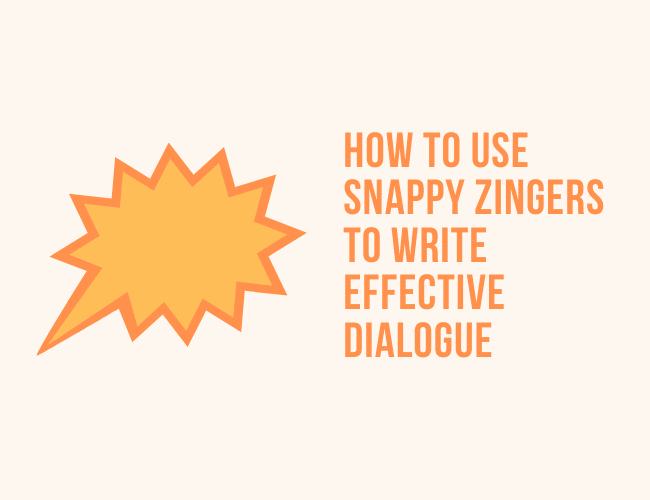Dialogue is an essential part of storytelling. We all know our characters speak to express themselves, and effective dialogue says a lot more than just the information conveyed—it also shows your character’s personality, range of knowledge, and their current state in the story.

But do you find that your characters sometimes drone on and on without getting to a point? Or that it seems to take a lot of words to get to the single idea you’re trying to get to? Or maybe you sometimes lose control of the exchange and find you don’t know which way to direct the conversation.
The problem is usually that your dialogue has too much “fluff.” Fluffy dialogue tends to slow down the story and bore the reader. But fear not; there are a few simple ways to remedy this.
The Zinger
In reality, people tend to say a lot of extra words. This may come as a surprise (it certainly did to me) that the way to create “realistic” dialogue in written fiction is to not write like how people speak in real life. In fact, in fiction, the fewer words used, the more realistic dialogue sounds.
One way to drive this point home is with the use of “zingers.” A zinger is a sharp, clever remark. It can be a snappy comeback, an insult, or just a funny comment.
Let’s consider this scene: Your two characters are trapped in a desperate situation, trying to open a puzzle lock to escape their prison. Neither character knows the answer and as time runs out, tension is mounting between them. You’re trying to show their growing desperation and frustration with each other. You write the dialogue like this:
A: Do you know what you’re doing?
B: You don’t know what you’re doing either!
A: Maybe we should try the tool again.
B: You already know that doesn’t work!
A: Well we’re running out of time!
B: I know that!
This exchange is okay. It shows both characters are upset and desperate.
And yet, in a situation where time is running out, this exchange seems to slow down the pacing. Your characters don’t need to spend a lot of time talking about the fact the tool doesn’t work or that time is running out. Instead, one snappy comment can communicate the stress they’re under.
A: Do you know what you’re doing?
B: Do YOU?
Now there is no question that they’re stressed, they’re rushed, and they’re frustrated. Not only are zingers efficient, they’re fun to read and communicate a certain cleverness about your characters as well.
Less is More
Effective dialogue is more than just the words spoken. The exposition in between can contribute to the “fluffiness” as well. The key to making any dialogue snappy and fun is knowing all the places to trim the excess.
Let’s take the following:
Miriam watched me help Penny into her dress. I could tell by the way she pursed her lips that she didn’t approve. Miriam never approved of anything I did.
“You chose green?” she asked in an annoying voice.
“Yes, I chose green,” I replied.
“You know green is for . . . women of ill repute.” I knew she meant whores.
“Well,” I said sarcastically, straightening Penny’s dress. “I wouldn’t question you on that.”
You can get a lot of information from this exchange. The women don’t get along. They’ve never gotten along. They take snipes at each other. They don’t agree on the dress.
The conversation is tense, but there’s also unnecessary meandering. Some things don’t need to be stated (I could tell she doesn’t approve) if they’re already indicated in the dialogue. Dragged-out dialogue and tags have a way of taking the drama and intensity out of a situation.
Instead of having all those extra words, let’s try this:
I helped Penny into her dress. Miram pursed her lips.
“Green?” she asked.
“Green.”
“Green is for whores.”
I wasn’t even surprised at her. “You would know.”
With a fraction of the words, the conversation—and the scene—are both intensified. You feel the tension between the women immediately without having to wade through a pile of “fluffy” words.
Don’t be afraid to let your characters get straight to the point. Your story will feel tighter and stronger for it.
Have you encountered trouble writing tight dialogue? Let us know in the comments.
PRACTICE
To practice writing snappy dialogue, write a short segment where two characters are having a conversation. It can be a variety of scenarios—a discussion, an argument, a love confession, an interrogation, etc.
First, write the conversation however you wish and figure out what it is the characters are talking about. Take no more than ten minutes to do this—it doesn’t need to be complicated.
Then, for the next five minutes, rewrite the same segment, take out unnecessary information, and make your characters get right to the point of the discussion. Use zingers if appropriate.
Share your two versions in the comments and don’t forget to leave feedback for your fellow writers!
J. D. Edwin is a daydreamer and writer of fiction both long and short, usually in soft sci-fi or urban fantasy. Sign up for her newsletter for free articles on the writer life and updates on her novel, find her on Facebook and Twitter (@JDEdwinAuthor), or read one of her many short stories on Short Fiction Break literary magazine.



0 Comments